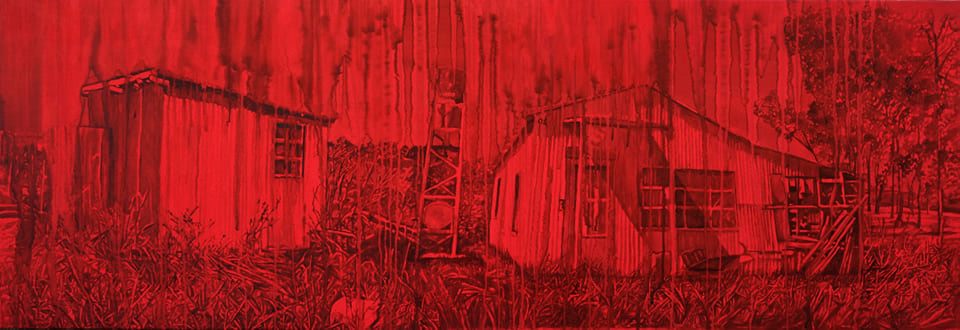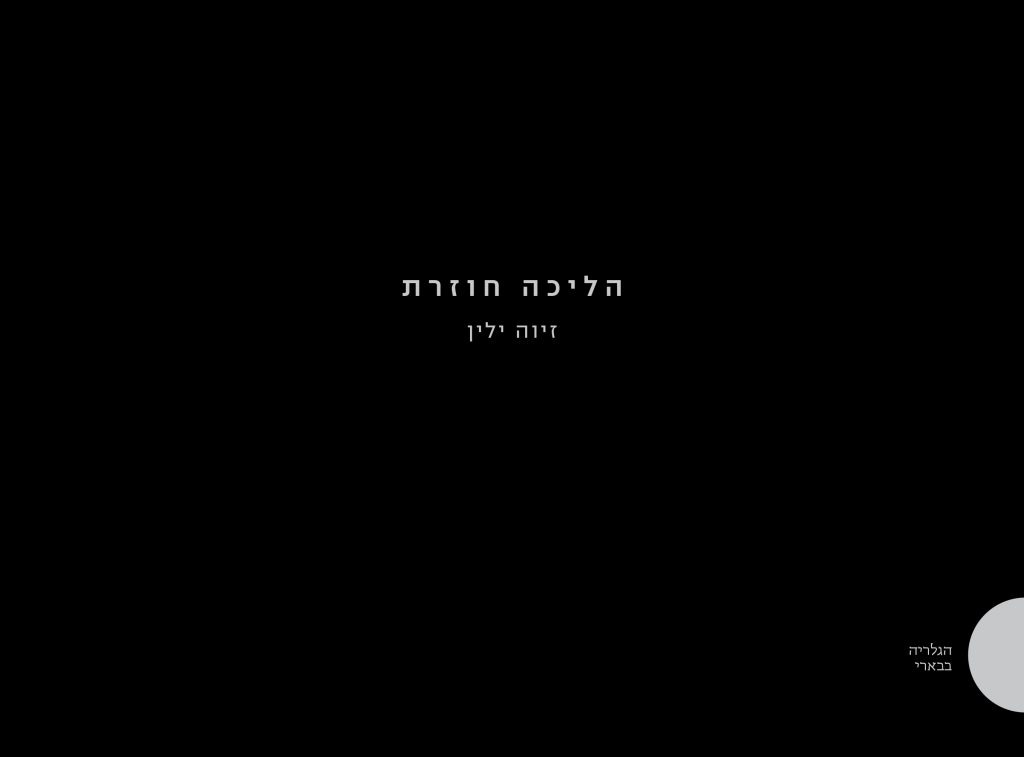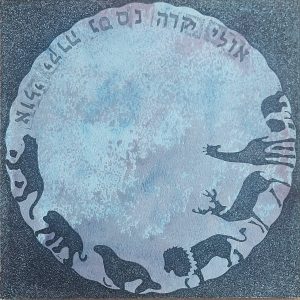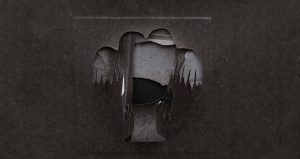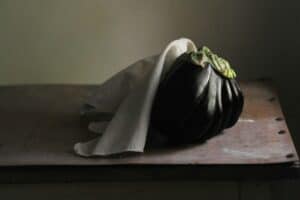A conversation with the work of Ziva Jelin
Red. Black. Dripping. The landscape of the Kibbutz from days long gone, low built sheds, winding paths. Trees. Bare, abundant. A sole water sprinkler, barrels. Not a person in sight.
First, the red paint is placed on the canvas. Jelin accidently stumbled upon it as things sometimes unfold, and it stayed and grew. What is that red that she places first? the color, beyond its cultural interpretations. What purpose does it serve? It is a painting by its own right. Filling the canvas. It is an urge. Then, she can breathe and begin the long, meticulous task of painting. The red is the first layer of her soul, almost. Just above the sub conscious, the place where conscious thoughts grow. On that layer she places memory. With a gentle hand, acutely sensitive to nuances of light and shape, she merges images from the Kibbutz archive as well as her personal one. Precisely and thoughtfully blending them together, creating an imaginary scenery. Fragments of moments fused together. Just like our memory I suppose.
Be’eri is that of days that came and went. A place you cannot know unless you lived to see it. A young Kibbutz, a time of communal sleeping. The infamous period in our history, that was subject to much debate and writing, that of broken dreams of a society and ideal and progress. Her work is not about this. But those are the times. Her childhood years shaped by temporary housing and the children group, and her immediate family. Trees and simple paths, rural houses, woods heavy with the aroma of pine trees and sticky resin. Those can still be found here, despite the accelerated expansion and new buildings.
In her work more is hidden than known. The known is the visible scenery unfolding through her eyes. Whose eyes are those? Young Ziva? “Ziva the Doll”? although they are images of her childhood, she looks upon them with mature eyes. Those are her eyes that are looking, you can feel it. And the red, potentially charged with unrest, builds up from painting to painting, descending into a hush. Creeping up slowly and infecting everyone, a silence full of awe. Winter stormy skies. And the hidden is hiding. In the woods, behind closed doors and shuttered blinds. They are a keeper of secrets. In the painting itself the secret revealed in the houses, is the red color of the base layer. Exposed and glowing. Last, she applies cold tar. Letting it erase the painting as is leaks down. It is an act of defiance against her own precision and need to be accurate. She embraces the loss of control and unruly aesthetics. The color palette changes. Departing from the black. From the red she does not. How can she depart from herself? And in red she paints the figure of her father. Not her father as a young man, the one from her childhood. Her father at the end of his long life, to whom she said goodbye, and with him she lost a part of herself. There is a part of us that is kept with our parents, our first years that we cannot remember, being a man’s daughter. Through the painting she says her farewell, processing the memory of that final departure.
The color palette changes. Departing from the black. From the red she does not. How can she depart from herself? And in red she paints the figure of her father. Not her father as a young man, the one from her childhood. Her father at the end of his long life, to whom she said goodbye, and with him she lost a part of herself. There is a part of us that is kept with our parents, our first years that we cannot remember, being a man’s daughter. Through the painting she says her farewell, processing the memory of that final departure. The first layer now has a yellowish tone. In some cultures, yellow symbolizes grief and mourning. What is this yellow here. It contains a sense of relief. Feeling lighter, it carries the weight of emotions and colors, the weight of heart ache. So we are not submerged. Her father’s facial features are painted with such accuracy. Love pours from each and every square of his flannel shirt. It feels so soft. What does it feel like to paint the face of a person once so close to you, now gone? Maybe it is broken down to small steps that can be coped with. One breath at a time. One square and then another. From brushstroke to brushstroke. One step to the next. Like life and overcoming grief The painting comes to an abrupt end, exposing the raw yellow canvas. That is the only painting she finished in this manner. The bare base layer continues, like a page from a book not yet written. Maybe there is no need to say anything, and just be for a moment. To breathe from and into the yellow. Sometimes there are really no more words. In another painting her mother places her hands on her father’s shoulders. His head bent forward. Eyes closed. He seems tired. Her mother is protective and guarding, comforting through her touch. The painting holds a realization of an end, of fragility.
Where is she walking to and what is she repeating? What can be safely said is that this is a journey. A movement through time, back to what she left behind, processes of internalization and assimilation, learning and growth. She walks to and from herself.

